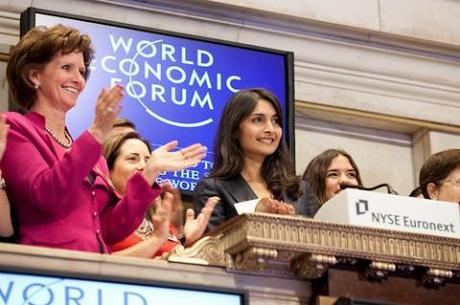
Saadia Zahidi, Senior Director, Head of the World Economic Forum’s Women Leader and Gender Parity Programme, visits the New York Stock Exchange with partner companies on International Women’s Day 2012. (Photo: WEF)
Women represent more than half of the world’s population and yet no single country has achieved full gender parity. A country’s global competitiveness depends on utilizing the human capital of its entire workforce, including the untapped skills and knowledge of women. Since 2006, the World Economic Forum has published its annual Global Gender Gap Report as a means of assessing and quantifying the state of gender equality in the world. The report focuses on four main factors that make-up individual country’s scores: “economic participation and opportunity, education attainment, health and survival and political empowerment.”
Taking a cross-regional perspective, the “ideal type” appears to be Scandinavian countries such as Iceland, Finland, Norway, and Sweden, which have reached the highest levels of gender equality and successfully eliminated many barriers to the economic and political participation of women in society. According to the 2013 Report, “no country has closed the economic participation gap or the political empowerment gap.” Overall, Nordic countries “have closed over 80 percent of the gender gap” and more specifically these states have reached universal literacy for both genders; one of the highest labor force participation rates for women in the world; narrow wage gaps between men and women; and high levels of female representations in politics and corporate boardrooms.
Globally, North America, where 74 percent of the gender gap has been closed, is the leading region based on the four performance indicators, followed by Europe and Central Asia with a score of 71 percent, Latin America and the Caribbean with 70 percent, Asia and the Pacific with 67 percent, Sub-Saharan Africa with 66 percent, and the Middle East and North Africa region with 59 percent. The report points to clear differences in gender equality globally and the unique challenges each geographic region must overcome in reaching its full economic potential through the full integration of women in the political and economic sphere – as CIPE’s Hammad Siddiqui discussed yesterday in the context of Pakistan.
While a nexus of factors have contributed to high levels of gender equality in Scandinavia such as extending suffrage to women in the early twentieth century and a robust welfare state that supports work-life balance and encourages women’s participation in the workforce, the benefits of gender equality have tremendous impact on economic growth and global competitiveness for all geographic regions. Studies show that one of the most decisive factors that determines national competitiveness are workforce characteristics such as “skills, education and productivity.” The 2013 Report shows that there is a positive “correction between gender equality and the level of competitiveness, GDP per capita and human development.” Narrowing the gender gap in education, labor force participation, and wages means that a country is utilizing its human resources efficiently and providing equal opportunities to all of its citizens, increasing economic growth and competitiveness.
For example, if European countries and the United States are able to close the gender gap, American GDP is predicted to increase by 9 percent and European GDP by 13 percent. Other benefits include fostering innovation and entrepreneurship through the incorporation of a more diverse set of perspectives. Women contribute to corporate decision making by implementing more inclusive and less risky decisions. Studies suggest investing in girls’ education is “one of the highest-return investments a developing country can make.”
While we observe global trends that generally are moving closer to closing the gender gap in economics, politics, education and health, no country has reached complete equality. Currently a person’s gender remains one of the most important determinants of his or her life opportunities. Not only is global gender equality the right thing to do, it is also an economic imperative that will guarantee national competitiveness and economic prosperity in the long run.
Theodora Mihaylova is a Research Assistant at CIPE.

